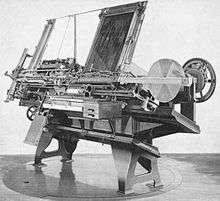Paige Compositor

The Paige Compositor was an invention developed by James W. Paige (1842–1917) between 1872 and 1888. It was designed to replace the human typesetter of a lead type-composed printing form with a mechanical arm.[1][2] However, the machine was not nearly as precise as it should have been and never turned a profit because of its complexity and continual need for adjustment based upon trial and error.[3][4]
The Paige typesetting machine is notable for substantial investment that prominent writer Mark Twain made into the failed endeavor: $300,000 ($5,935,833 today). Twain, a former printer, invested not only the bulk of his book profits but also a large portion of the inheritance of Olivia Clemens, his wife.[4] Many point to his over-investment in the Paige typesetting machine and other inventions as the cause of not only his family's financial decline but also the decline of his wit and humor.[5]
Only two machines were built. One was donated by Cornell University for a scrap metal drive during World War II. The other machine survives and is displayed at the Mark Twain House in Hartford, Connecticut.[6]
References
- ↑ Lundin, Leigh (2011-05-22). "Tom Sawyer and the Diabolus Ex Machina". Redding: Criminal Brief.
- ↑ Lienhard, John (2000). "The Paige Compositor". Engines of Our Ingenuity. Houston: University of Houston (1372). ISBN 978-0-19-516731-3. Archived from the original on 1998.
- ↑ Lienhard, John (1988). "The Paige Compositor". Engines of Our Ingenuity. Houston: University of Houston (0050). ISBN 978-0-19-513583-1. Archived from the original on 1997.
- 1 2 Kirk, Connie Ann. Mark Twain, a Biography. Connecticut: Greenwood Printing, 2004. PS1331.K57.
- ↑ "Mark Twain, a Life" Ron Powers
- ↑ "Our Collection". Mark Twain House and Museum. Retrieved 28 July 2013.
External links
- Page at ERIC
- U.S. Patent 157,694 Precursor by Paige (patent application filed 1872)
- U.S. Patent 547,859 Paige Compositor patent (application filed 1882)
